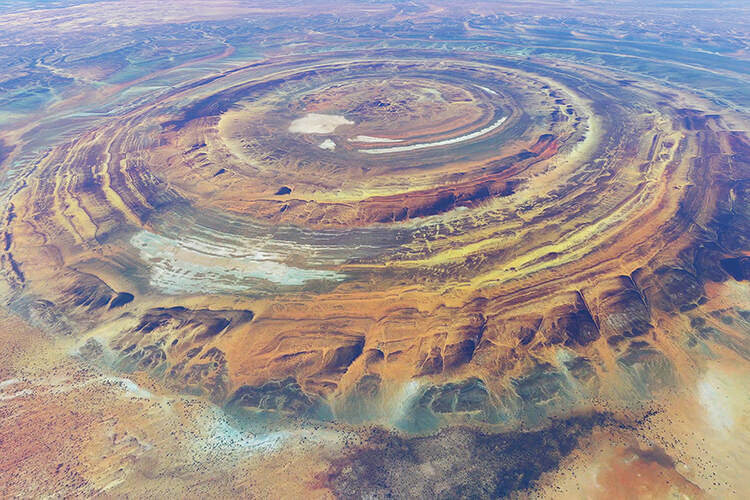17 November 2025, Mauritania
In a landmark announcement that resolves one of geology’s most captivating enigmas, a multinational consortium of scientists has definitively unveiled the origins of the Richat Structure, more famously known as the Eye of Africa. This colossal, bullseye-shaped feature in the Sahara Desert, visible from space and long shrouded in speculative myths ranging from Atlantis to an ancient meteorite strike, is now understood to be the result of a complex, multi-stage geological process that began over a billion years ago. The findings, published today in the journal Nature Geoscience, culminate more than five decades of intense debate and field research, finally providing a comprehensive model for the structure’s formation.
For decades, the prevailing theories about the Eye of Africa fell into two main camps. The most popular, and publicly captivating, was the impact hypothesis, which suggested the structure was the scar of a massive asteroid collision. However, the lack of shock-metamorphosed minerals, such as coesite or stishovite, and the absence of a recognizable impact crater structure always left this theory on shaky ground. The alternative, and ultimately more persistent, theory was that it was the remnants of a volcanic eruption. Proponents pointed to the presence of igneous rocks like rhyolite and gabbro, suggesting a collapsed volcanic caldera. Yet, this too failed to fully explain the structure’s perfect circularity and the intricate sequence of exposed sedimentary layers. The mystery was so profound that it even fueled alternative historical theories, with some suggesting it was the location of the lost city of Atlantis, though scientists universally dismissed this for a complete lack of archaeological evidence.
The breakthrough came from the GECOS (Geological and Erosional Chronology of the Sahara) Initiative, a five-year project that employed a combination of advanced satellite imagery analysis, subsurface geophysical surveys, and painstaking on-the-ground geological mapping. The team collected and analyzed hundreds of rock samples from the structure’s concentric rings, dating them with unprecedented precision using uranium-lead and argon-argon radiometric dating techniques. What they constructed was not a story of a single catastrophic event, but a billion-year saga of geological violence and patient erosion.
The new research posits that the story began approximately 1.1 billion years ago, during the Proterozoic Eon, with the initial driver being not an impact from above, but immense forces from below. The study concludes that the Eye is the surface expression of a massive magmatic intrusion. As molten rock, or magma, pushed upwards towards the Earth’s crust, it failed to erupt onto the surface. Instead, it created a giant, dome-shaped blister of rock, lifting and fracturing the overlying sedimentary layers of limestone, sandstone, and other rocks into a perfect circular dome, known as a geologic dome.
Dr. Aris Thira, lead geologist from the University of Oslo and head of the GECOS Initiative, explained the process: “Imagine pushing a fist slowly up from beneath a stack of layered tablecloths. The cloths would arch upwards, and the concentric folds and fractures you’d create are a perfect analogue for what happened here on a gigantic scale. The Earth did the pushing, with a plume of magma as its fist. This doming process created the fundamental bullseye pattern we see today.”
However, the formation did not stop there. The magmatic intrusion also set the stage for the second act of the drama. The heat and fluids from the cooling magma below circulated through the fractured dome, chemically altering the rocks and making some layers more resistant to erosion than others. This crucial detail explains why the rings stand so prominently today. For hundreds of millions of years, the forces of wind and water meticulously scoured the landscape. The softer sedimentary layers, like the clay-rich formations, eroded away more easily, carving out the valleys, while the harder, quartz-rich layers, toughened by the thermal fluids, remained as the prominent ridges.
The final, critical piece of the puzzle was the role of continental breakup. The research team found compelling evidence linking the doming event to the initial rifting of the supercontinent Rodinia. The same tectonic forces that were pulling the continent apart created weaknesses in the Earth’s crust, facilitating the upward movement of the magma that formed the dome. This provided a clear tectonic context that had been missing from previous models.
Professor Lena Schmidt of the German Research Centre for Geosciences, a co-author of the study, emphasized the power of erosion in sculpting the final product: *”The Eye of Africa is not a construction, but a revelation. The magmatic dome provided the template, but it was the relentless, patient work of erosion over eons that stripped away the overburden and exposed this magnificent geological cross-section. We are looking at a natural core sample, over 40 kilometers wide, revealing Earth’s history from the surface down to deep crustal levels.”*
The implications of this discovery extend far beyond solving a geological mystery. The Richat Structure now serves as a pristine, open-air laboratory for understanding planetary geology. Its exposed layers provide an unparalleled record of environmental changes in the Sahara over hundreds of millions of years, shifting from a lush, river-filled landscape to the arid desert we see today. Furthermore, the detailed understanding of how such domes form and erode is directly applicable to mineral exploration and the study of similar features on other planets.
As Dr. Thira concluded: “This research closes a long chapter of speculation and opens a new one of understanding. The Eye of Africa is no longer a mystery, but a benchmark. It teaches us about the immense forces that shape our planet, the delicate interplay between internal heat and surface processes, and provides a stunningly clear window into a billion years of Earth’s history. The truth, as it often is in geology, proved to be more complex and more beautiful than any single catastrophic myth.” With the debate now settled, the Eye of Africa stands not as a question mark, but as a definitive and majestic monument to the dynamic life of our planet.




